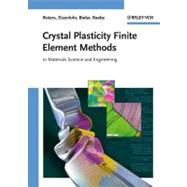
Note: Supplemental materials are not guaranteed with Rental or Used book purchases.
Purchase Benefits
What is included with this book?
| Introduction | |
| Basic Assumptions on the Continuum Theory of Continuous Distributions of Lattice Defects | |
| Crystalline Anisotropy and the Spirit of the Crystal Plasticity Finite Element Method | |
| The Crystal Plasticity Finite Element Method as a Multi-Mechanism and Multi-Physics Platform | |
| Concise Historical Overview | |
| Flow Kinematics | |
| Constitutive Models | |
| Introduction | |
| Phenomenological Constitutive Models | |
| Physics-based Internal Variable Constitutive Models | |
| Displacive Phase Transformations in CPFE Modeling | |
| Introduction | |
| Martensite Formation and Transformation-Induced Plasticity in CPFE Models | |
| Mechanical Twinning in CPFE Models | |
| Homogenization Methods in CPFE Analysis | |
| Introduction | |
| Statistical Representation of Crystallographic Texture | |
| Computational Homogenization | |
| Mean-field Homogenization | |
| Grain-Cluster Methods | |
| Crystal Plasticity FE Approaches to Local Damage Analysis | |
| Continuum Approaches to Modeling Damage | |
| Microstructurally Induced Damage | |
| Assessment of Current Knowledge about Damage Nucleation | |
| Numerical Aspects Associated with the CPFE Method | |
| General Remarks | |
| Integration Methods | |
| Explicit versus Implicit | |
| Element Types | |
| Experimental Validation and Application | |
| Introduction | |
| Microscopic and Mesoscopic Examples | |
| Macroscopic Examples | |
| Challenges | |
| Conclusions | |
| Table of Contents provided by Publisher. All Rights Reserved. |
The New copy of this book will include any supplemental materials advertised. Please check the title of the book to determine if it should include any access cards, study guides, lab manuals, CDs, etc.
The Used, Rental and eBook copies of this book are not guaranteed to include any supplemental materials. Typically, only the book itself is included. This is true even if the title states it includes any access cards, study guides, lab manuals, CDs, etc.